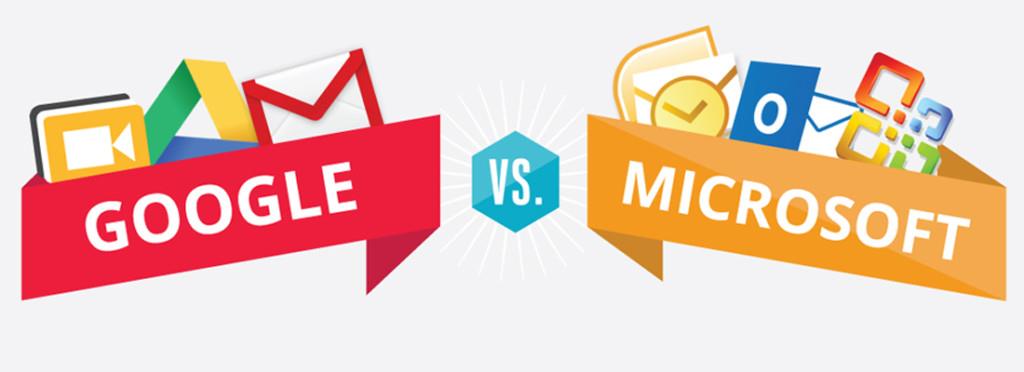April 2, 2015
Google only waited a few days to respond to news reports that Microsoft was working with its vendors to offer $149 WIndows 10 laptops. The search giant countered its rivals plans by officially announcing multiple versions of its Chromebook which will sell for $149 and a new "stick" computer-like device being sold for under $100.

April 2, 2015
Google only waited a few days to respond to news reports that Microsoft was working with its vendors to offer $149 WIndows 10 laptops. The search giant countered its rivals plans by officially announcing multiple versions of its Chromebook which will sell for $149 and a new "stick" computer-like device being sold for under $100.

Google vs. Microsoft: Which Platform is the Real Change?
This is very good news for consumers as the ongoing war between the two companies keeps driving prices down while quality and performance have to be at least somewhat maintained.
Since its launch, Chromebooks, which are web-driven computers running Chrome OS, have largely been a price play. They were cheaper than low-end PC laptops running Windows and dramatically cheaper than Apple iPads and MacBooks. They also have a traditional laptop form factor which made them appealing to people looking for a secondary machine mostly for light use and web browsing and to schools put off by the price of iPads and Windows-based laptops.
As a pure pricing play Chromebook made sense. The web-based machines offered a good-enough solution for people looking to browse the Internet and use Google's Office-like suite of products.
But with Microsoft matching prices, you have to wonder how big the market will be for Google's very-limited laptops when machines running Windows can be had for the same price.
Late to the party
These latest price drops continue a war that Microsoft was a little late entering. Chromebooks came on strong in 2014, capturing a large chunk of the educational market that had previously been dominated by machines running Windows and Apple iPads.
In the 2014 back-to-school period, Chromebooks did a number on Microsoft's sales in the education market, according to data from IDC. Windows-based devices dropped to a 51% market share last year from a 63% market share in 2013, according to the research firm.
Microsoft countered, albeit too late for the 2014-2015 school year, by introducing a few sub-$200 laptops for the 2014 holiday season including the HP Stream, a model of which I purchased for my wife and son. The Stream is Chromebook-like in its design and tech specs with it having limited on-board memory and hard-drive storage coupled with web-based additional capacity.
It's a pretty decent machine which runs Office well. Its plastic construction is a bit flimsy and it has a trackpad which can be a bit hard to use, but overall, I have found it to be a perfectly viable and versatile laptop which cost less than $200.
The Stream does everything a Chromebook does plus it includes a free year of Office 365. It also works entirely independent of an Internet connection while Google's laptops are very limited when not connected.
What's happening now
Having seen some success at the $199 level — Google mostly in schools and Microsoft over the holiday season — the two companies are looking to push prices lower.
Microsoft is looking to release "two new inexpensive projects targeting the education and consumer markets. The projects are 11.6-inch clamshell-type notebooks priced at US$149-179 and set for release in mid-2015, at the earliest," DigiTimes reported. The tech news website shared some details:
Both notebooks adopt Intel's Bay Trail-T CR processors, while the one for educational purposes will be manufactured with Elitegroup Computer Systems' help and will be sold mainly through the education channel that Intel and ECS built for their Classmate PC products…The one for the consumer market will be developed and manufactured by China-based 3 Nod and sold via brand vendors.
Prices for the new WIndows 10 machines are expected to start at $149.
Google has formally announced "the Haier Chromebook 11 (available at ) and the Hisense Chromebook (available at )," the company wrote on its blog. "These new Chromebooks are fast, lightweight, have long-life batteries and are available for pre-order today for $149." The search company also announced the Chromebit, a candy bar sized computer-like device which plugs directly into an HDMI monitor. Final pricing has not been released, but Google said it would be less than $100.
The stakes have been raised
As a cheaper alternative to Windows-based machines and iPads, Chromebooks made sense. But with Microsoft showing a willingness to match Google's pricing, it seems that Google's audience shrinks to people who want machines with constrained functionality. That may still appeal to schools since Chromebooks are easy to maintain and it may work for small niches of users like elderly people who only want basic web access.
Overall, however, Chromebooks are solving a problem which no longer exists. It's very hard to make "less functionality for the same price" a compelling pitch. Assuming the $149 Windows 10 laptops are roughly comparable in manufacturing quality to the Chrome machines it's hard to see why you would buy a Chromebook.
Google had a good idea, but it was one based more on price than usability and Microsoft has matched its pricing while offering a lot more functionality. Windows machines may not eliminate Chromebooks from the market, but they should stop their growth and start to win back share for Microsoft.
Courtesy: Motley Fools – Article originally appeared on Fool.com
















































































































